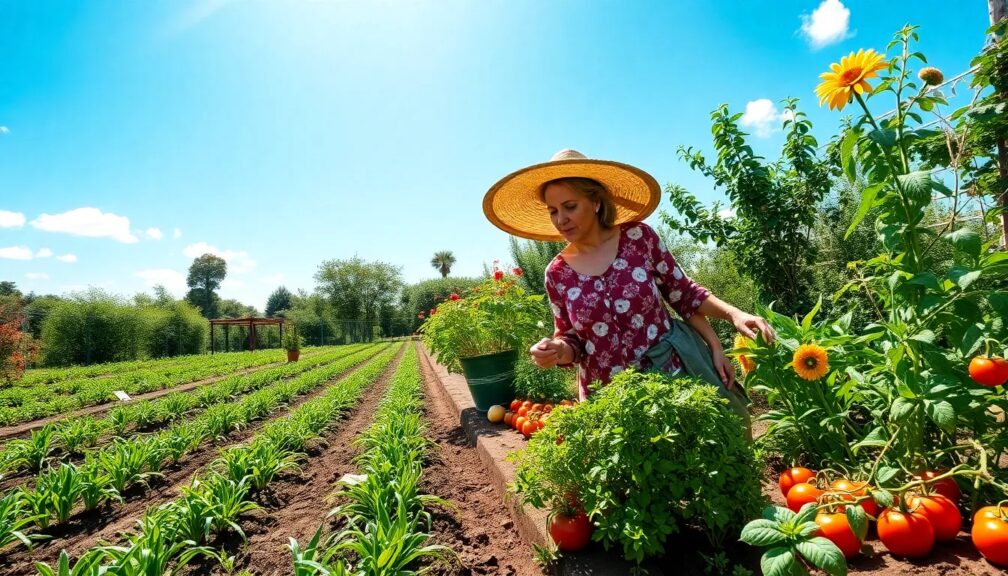Is it better to plant vegetables in rows or groups

When it comes to cultivating a thriving vegetable garden, gardeners are often faced with the decision of planting their veggies in neat rows or clustering them in groups. This choice can influence not only the visual appeal of your garden but also the health of your plants, their yield, and the overall ease of maintenance. Both methods have their merits and can be beneficial depending on the specific conditions and goals of your garden. In this article, we will explore the advantages and disadvantages of each planting strategy, consider the impact on soil health, pest management, and water usage, and provide you with the information you need to make the best choice for your green space. Whether you're a seasoned gardener or just starting out, understanding the implications of planting in rows versus groups can lead to a more productive and manageable garden. Let's delve into the world of vegetable gardening techniques to help you maximize your harvest.
What is the most efficient vegetable garden layout?
Discover the secrets to maximizing your harvest and optimizing the use of space in your backyard! Tailoring the layout of your vegetable garden can make a tremendous difference in plant health, yield, and overall ease of care. The most efficient vegetable garden layout is not a one-size-fits-all solution; it gently weaves together the principles of space-saving, companion planting, and crop rotation to suit your unique setting.
Imagine stepping into a garden where every inch of soil is utilized to its full potential, giving life to lush, vibrant vegetables that are ready to grace your table. Picture a harmonious environment where plants naturally detoxify the soil and deter pests, reducing the need for chemical interventions. This is not just a dream—it can be your reality.
Here's a sneak peek into efficiency tactics that could revolutionize your gardening game:
- Vertical gardening: Going up? Use trellises, stakes, and cages to grow climbers like tomatoes and cucumbers, freeing up precious ground space for other crops.
- Raised beds: These can improve drainage and root health, offering a controlled environment for your plants to thrive in.
- Square foot gardening: Segment your garden into one-foot squares to manage different crops effectively, reducing waste and focusing resources where they are most needed.
- Succession planting: Don't let your soil take a break; by planning, you can have a continuous supply of vegetables throughout the season.
- Companion planting: Pairing up certain plants can be beneficial, as some combinations can enhance growth, flavor, and protection against pests.
But wait, there's more! The ideal layout incorporates knowledge of sunlight patterns, water access, and the specific growth habits of each vegetable you choose to plant.
Don't let the intricacies overwhelm you; instead, let them intrigue you. With the right approach, the most efficient vegetable garden layout will not only be a rewarding hobby but also a powerhouse of productivity. Stay tuned to uncover the full blueprint that will turn your garden into an envy-inducing oasis of abundance.
Is it better to plant in rows or blocks?
Discover the secrets that experienced gardeners have been leveraging for years to maximize their yields and beautify their spaces! You might think that traditional row planting is the way to go, but don't make up your mind just yet. Block planting has been revolutionizing small and large-scale gardens alike.
First, consider the incredible potential of block planting for boosting your garden's productivity. This method optimizes space by creating dense patches of plants which, in turn, can lead to a more abundant harvest. Not only that, but it also fosters a supportive microclimate where plants protect each other from the harsh elements. The question you should be asking isn't just about aesthetics; it's about creating an ecosystem that thrives.
On the other hand, traditional row planting boasts its own set of advantages. The familiar sight of neat rows has been a symbol of organized agriculture for centuries. But is tradition always the best path to follow? With advancements in gardening knowledge and techniques, sticking to rows without considering the alternatives might mean you're missing out on a game-changer for your garden.
Dig deeper, and you'll uncover the ways these planting strategies can serve different types of plants. Delve into the intricacies of airflow, watering efficiency, and ease of harvest. Could it be that some plants prefer the structure of rows, while others flourish in the community of a block?
And don't get started on the impact of each method on pest control and disease management. Imagine a scenario where you spend less time battling garden invaders and more time enjoying the fruits of your labor. The layout of your garden could make or break this vision.
Are you ready to unlock the next level of gardening success? Stay tuned as we delve into the pros and cons of each method, ensuring you're equipped to make the best decision for your green haven. The answer may surprise you, and you won't want to miss the insights that could transform your gardening experience.
What vegetables grow best in rows?
Imagine stepping into your garden, where the sight of lush, vibrant rows of vegetables greets you. There's a secret to achieving this picture-perfect produce—planting in rows. Not only does this method conserve space and reduce competition for nutrients, but certain vegetables absolutely thrive when given the orderly structure of row planting.
First, let's talk about root vegetables, such as carrots, beets, and radishes. These underground treasures need room to expand and grow deep into the soil. Rows allow for precise spacing, which, in turn, leads to more substantial and healthier yield.
Then there's the family of leafy greens—lettuce, spinach, and kale. Row planting assists in efficient weeding and watering, ensuring that these greens get the care they need without the added labor. Imagine the crisp, fresh salads you could toss together with greens from just a few feet away.
Don't forget about legumes like peas and beans. They're known for their ability to fix nitrogen in the soil, enhancing fertility for future crops. When sown in rows, these plants can be easily supported with stakes or trellises, encouraging upward growth and making harvest a breeze.
Time to talk about the heavy-hitters—corn and potatoes. They are the staples of many gardens, and when lined up in rows, they utilize space effectively and make for easier maintenance and harvesting. Just picture the sweet, buttery corn on the cob and the earthy, homegrown potatoes you could be enjoying.
And finally, onions and garlic. These flavor-packed bulbs benefit from row planting as it allows for better air circulation, which is essential for their development. Imagine the aromatic dishes that could be elevated with your own hand-picked onions and garlic.
The truth is, many vegetables can prosper in rows, but the ones mentioned above are just the beginning. By organizing your garden in this way, you'll not only maximize your space but also make it easier to manage pests and diseases. The rows create a roadmap for your garden adventures, leading to a more fruitful harvest.
By now, you must be envisioning the potential of your own row garden, teeming with the freshest, most delectable vegetables. If you're curious to learn more and ready to transform your garden into a row-planted paradise, then let's dig deeper into the strategies that will turn this vision into reality. Your garden, and your kitchen, will thank you for it.
Which vegetables shouldn't be planted next to each other?
When it comes to cultivating a thriving vegetable garden, what you don't know can hurt your plants. Imagine spending months tending to your garden, only to yield a meager harvest. The culprit? Improper plant companions. The art of companion planting holds ancient secrets that modern gardeners are rediscovering with a mix of curiosity and awe.
The concept is simple yet profound: certain vegetables, when planted together, can either bolster each other's growth or lead to disastrous results. Take the case of tomatoes and potatoes. These two might be perfect for a summer salad, but in the ground, they're adversaries, making each other vulnerable to the same blight. And if you plant onions near your beans, you might as well wave goodbye to those savory legumes.
But wait, there's a twist. Some unlikely pairings can unlock hidden potential in the soil, acting as natural protectants against pests and diseases. The key lies in understanding these relationships. Here's a glimpse into the world of vegetable matchmaking gone wrong:
1. Beans and Onions: These are classic frenemies. While they might coexist in a stir-fry, in the garden, their rivalry can weaken bean growth.
2. Carrots and Dill: They might sound like a dream team in the kitchen, but in the soil, dill can stunt carrot growth.
3. Cucumbers and Aromatic Herbs: The strong scents of herbs like sage can be overwhelming, causing cucumbers to struggle.
This is just the tip of the iceberg. The list of incompatible plant pairings is as extensive as it is surprising. But don't let this dishearten you. With each unfavorable match comes a wealth of beneficial companions that can bring your garden to new heights.
Are you ready to dive into the world of companion planting? Discover the secrets that can turn your garden from a battleground into a sanctuary for all your favorite vegetables. The answers are waiting, and your green thumb is the key. Prepare to unlock the full potential of your garden, one plant pairing at a time.
Raised rows vs flat rows
Imagine stepping into your garden, where the fruits of your labor have blossomed into a lush, bountiful oasis. The secret? Understanding the critical differences between raised and flat rows. These seemingly simple choices in garden design can have a profound impact on your gardening success.
But what makes one method superior to the other? Is it the enhanced drainage and root growth that raised rows offer? Perhaps it’s the simplicity and tradition of flat rows that resonates with the purist gardeners.
Here's a sneak peek into the world of advanced gardening techniques:
1. Drainage: With raised rows, excess water is no longer a worry. Your plants will sit high and dry, safe from the risk of root rot.
2. Soil Quality: Control is in your hands. Fine-tune the soil mixture in raised rows to suit the specific needs of your plants, optimizing their growth potential.
3. Aeration: Let your plant's roots breathe easier. The elevated structure promotes better air circulation, which is essential for healthy plants.
4. Ease of Access: Say goodbye to back-breaking gardening. Raised rows bring the garden up to you, making maintenance a breeze.
5. Pest Control: Elevated soil can be a natural barrier to some common garden pests, giving your plants an added layer of protection.
Meanwhile, flat rows have their own set of advantages. They can be:
- Cost-Effective: Minimal setup means more money in your pocket.
- Traditional: There’s a timeless charm to the classic garden layout.
- Space-Efficient: Maximize your growing area without the need for additional structures.
Are you leaning towards the innovation of raised rows or the simplicity of flat rows? The choice may seem daunting, but fear not—the decision could unlock unparalleled yields and gardening pleasure. Stay tuned to discover how you can revolutionize your garden, improve your harvest, and become the envy of gardeners everywhere. The answer lies in the soil beneath your feet.
Consejo final: Consider your garden's specific conditions and your personal preferences when deciding between planting vegetables in rows or groups. Rows allow for easier access and maintenance, while groups can create a beneficial microclimate for your plants. Whatever method you choose, ensure good soil, adequate sunlight, and proper watering for a successful harvest. Wishing you a bountiful and enjoyable gardening experience.
 How do I prepare my yard for a garden
How do I prepare my yard for a garden What should I grow first in my garden
What should I grow first in my garden What do farmers use to turn over soil
What do farmers use to turn over soil What is the best tool to cut large branches when pruning shrubs
What is the best tool to cut large branches when pruning shrubs What is the best tool for cutting back perennials
What is the best tool for cutting back perennialsIf you want to know more about similar articles like Is it better to plant vegetables in rows or groups you can visit category Gardening Tools.
Deja una respuesta